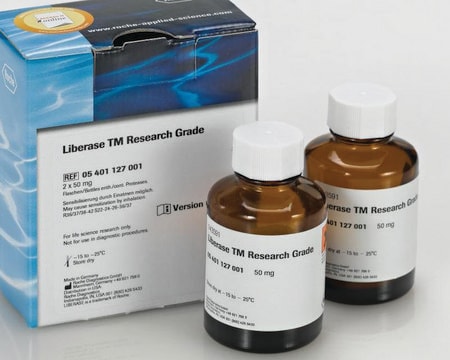04536282001
Roche
DNase I recombinant
grade I, from bovine pancreas, expressed in Pichia pastoris
About This Item
Prodotti consigliati
Origine biologica
bovine pancreas
Livello qualitativo
Ricombinante
expressed in Pichia pastoris
Stato
lyophilized
Attività specifica
(>10,000 U/bottle according to Kunitz (+25°C; DNA as substrate).)
PM
39 kDa
Confezionamento
pkg of 2 × 10,000 U
Produttore/marchio commerciale
Roche
Concentrazione
≥70-90%
tecniche
protein extraction: suitable
Colore
white to light yellow
Solubilità
water: soluble
Compatibilità
suitable for molecular biology
N° accesso NCBI
N° accesso UniProt
applicazioni
sample preparation
Attività estranea
Proteases, none detected
RNase, none detected
Temperatura di conservazione
2-8°C
Informazioni sul gene
bovine ... DNASE1(282217)
Descrizione generale
Activity: 10,000U/bottle according to Kunitz (+25°C; DNA as substrate).
Unit definition: One unit is the enzyme activity that causes an increase in the absorbance of 0.001 per minutes under assay conditions.
Applicazioni
- DNase I, recombinant, grade I is used for:Eliminating DNA during protein isolation procedures
- Analysis of chromatin structure
- Eliminating DNA during sample preparation
Caratteristiche e vantaggi
Lyophilizate
Definizione di unità
Assay mixture: Calf thymus DNA (100 μg) is incubated with 20 to 50 U DNase I at +25 °C.
The increase in absorbance is measured at 260 nm.
Information Note: These conditions are used for the determination of activity,according to Kunitz, since the Kunitz assay results in high reproducibility and sensitivity. When using this enzyme for normal experimental purposes, Roche recommends using incubation buffers that are appropriate for a given application, e.g., as mentioned in the standard literature (Sambrook et al., Curr. Prot. Mol. Biol., etc.).
Nota sulla preparazione
Storage conditions (working solution): Long-term Storage of the Dissolved Enzyme
The solvent generally recommended for DNase I is water. When DNase I is reconstituted in water, the solution can be kept for 2 days at 2 to 8 °C and for 1 month at -15 to -20 °C. For best results, prepare appropriate aliquots and avoid repeated freezing and thawing. However, for long-term storage, carefully dissolve DNase I in one of the buffers listed below. In buffer 1, the enzyme will be stable for several weeks. The enzyme will be stable for at least 18 months if it is dissolved in buffer 2, 3, or 4 and stored at the recommended temperatures.
Information note: Do not vortex the enzyme while dissolving!
Buffer 1: 20 mM Tris-HCl, 20 mM MgCl2, 5 mM CaCl2, 0.1 mM dithioerythritol, 0.1 mM EDTA, 50% (v/v) glycerol, pH 8. Store this solution at -15 to-25 °C; it will not freeze at this temperature and will be stable for several weeks.
Buffer 2: 20 mM Tris-HCl, 50 mM NaCl, 1 mM dithioerythritol, 100 μg/mL BSA, 50% glycerol (v/v), pH 7.6. Store this solution at -15 to -25 °C for up to 18 months; it will not freeze at this temperature.
Buffer 3: 20 mM Tris-HCl, 1 mM MgCl2, 50% (w/v) glycerol, pH 7.5. Store this solution at -15 to -25 °C for up to 18 months; it will not freeze at this temperature.
Buffer 4: 20 mM Tris-HCl, 1 mM MgCl2, pH 7.5. Aliquot in appropriate amounts (e.g., 10 μl), freeze the aliquots quickly on dry ice, and store at -60 °C or below for up to 18 months. Thaw only the amount needed for each experiment. Do not refreeze. Discard any leftover thawed solution.
Stoccaggio e stabilità
Altre note
Avvertenze
Danger
Indicazioni di pericolo
Consigli di prudenza
Classi di pericolo
Resp. Sens. 1 - Skin Sens. 1
Codice della classe di stoccaggio
11 - Combustible Solids
Classe di pericolosità dell'acqua (WGK)
WGK 1
Punto d’infiammabilità (°F)
does not flash
Punto d’infiammabilità (°C)
does not flash
Scegli una delle versioni più recenti:
Possiedi già questo prodotto?
I documenti relativi ai prodotti acquistati recentemente sono disponibili nell’Archivio dei documenti.
I clienti hanno visto anche
Il team dei nostri ricercatori vanta grande esperienza in tutte le aree della ricerca quali Life Science, scienza dei materiali, sintesi chimica, cromatografia, discipline analitiche, ecc..
Contatta l'Assistenza Tecnica.











